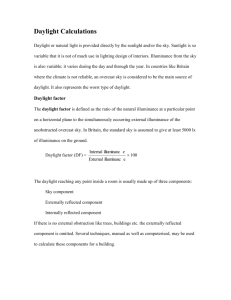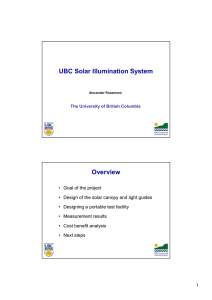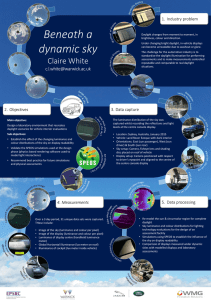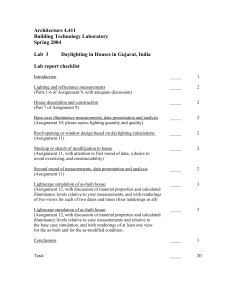enhancing energy efficiency of built environment through daylight
advertisement
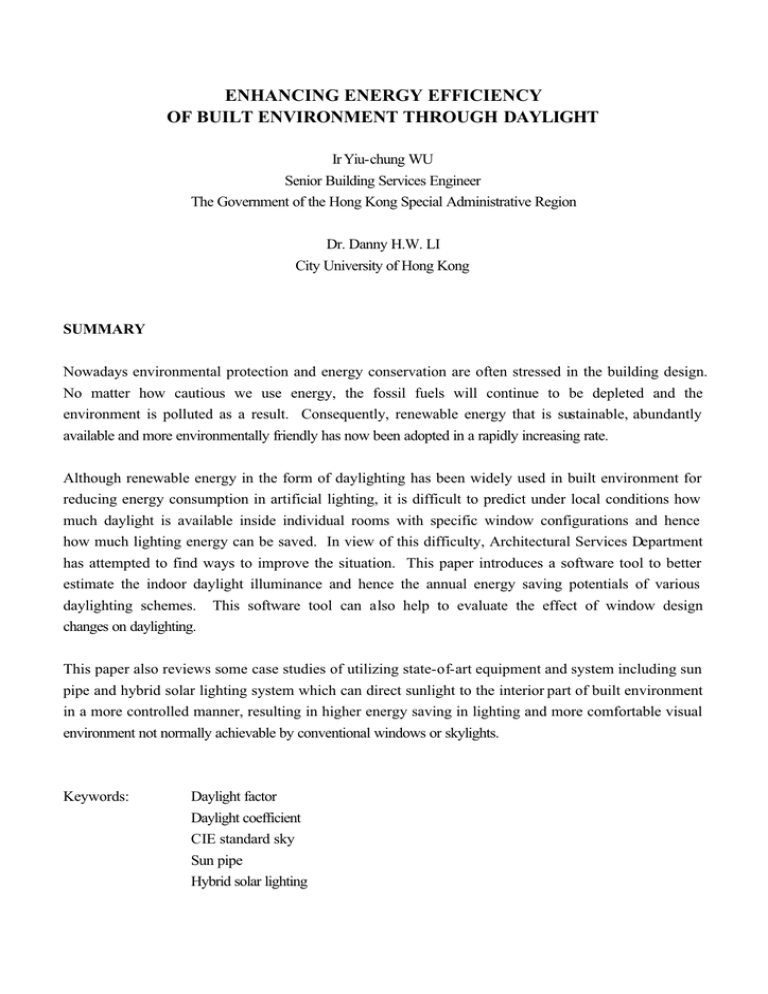
ENHANCING ENERGY EFFICIENCY OF BUILT ENVIRONMENT THROUGH DAYLIGHT Ir Yiu-chung WU Senior Building Services Engineer The Government of the Hong Kong Special Administrative Region Dr. Danny H.W. LI City University of Hong Kong SUMMARY Nowadays environmental protection and energy conservation are often stressed in the building design. No matter how cautious we use energy, the fossil fuels will continue to be depleted and the environment is polluted as a result. Consequently, renewable energy that is sustainable, abundantly available and more environmentally friendly has now been adopted in a rapidly increasing rate. Although renewable energy in the form of daylighting has been widely used in built environment for reducing energy consumption in artificial lighting, it is difficult to predict under local conditions how much daylight is available inside individual rooms with specific window configurations and hence how much lighting energy can be saved. In view of this difficulty, Architectural Services Department has attempted to find ways to improve the situation. This paper introduces a software tool to better estimate the indoor daylight illuminance and hence the annual energy saving potentials of various daylighting schemes. This software tool can also help to evaluate the effect of window design changes on daylighting. This paper also reviews some case studies of utilizing state-of-art equipment and system including sun pipe and hybrid solar lighting system which can direct sunlight to the interior part of built environment in a more controlled manner, resulting in higher energy saving in lighting and more comfortable visual environment not normally achievable by conventional windows or skylights. Keywords: Daylight factor Daylight coefficient CIE standard sky Sun pipe Hybrid solar lighting 1.0 Introduction 1.1 Daylight through Window Daylighting is an effective sustainable development strategy to alleviating the problems in energy and environment, and improving the qualities for visual comfort and health. Daylight is considered as the best source of light for good colour rendering and its quality is the one light source that most closely matches human visual response. The amount of daylight penetrating a building is mainly through window openings which provide the dual function not only of admitting light for indoor environment with a more attractive and pleasing atmosphere, but also allowing people to maintain visual contact with the outside world. People desire natural lighting in their living and working environments. Recently, greater recognition has been given to the contribution that daylight can make energy conservation in buildings. In subtropical Hong Kong, most of the electricity is used for creating a thermally and visually comfortable built environment through air-conditioning and artificial lighting. Artificial lighting is one of the major electricity-consuming items in many non-domestic buildings. Many studies have indicated that proper lighting controls integrated with daylighting have a strong potential for reducing lighting energy demand by exploiting daylight more effectively. Daylighting is an effective approach to allow architectural design and construction practice to have a more flexible building façade design strategy, and to enhance a more energy efficient and greener building environment. Automatic artificial lighting control could be achieved easily by using photo sensors together with dimmers. In response to the availability and intensity of daylight, artificial lighting can be turned on or off, or dimmed to maintain a pre-determined illuminance to the environment concerned. At this stage, the prediction of indoor daylight illuminance is critical in the design of such photo sensor and dimmer systems in order to achieve the most optimal energy saving. The traditional methodology in prediction of daylight illuminance is very complicated and the simulation computer software tools available in the market are too sophisticated to be practically applied for the design of high rise buildings with numerous rooms. Simple software tool would be useful especially during preliminary design stage when different conceptual design schemes are being considered. In order to simplify the design process of photo sensor system and the estimation of the energy saving potential, a simple daylight prediction method together with a user-friendly and fast processed computer software are developed. The simple software tool can be used to compute the interior daylight illuminance and lighting energy savings. The software tool has been gone through a verification process which is conducted based on a well developed lighting simulation programme, RADIANCE. 1.2 Daylight through Light Transportation System In recent years, some start-of-the-art light transportation systems have been developed to collect and guide the daylight to interior areas without window or skylight; or interior areas where they are too far away from window. In this paper, sun pipe system and hybrid solar lighting system will be described. 2.0 Simplified Daylight Illuminance Prediction Method 2.1 Design Concept Traditionally, the daylight illuminance is determined in terms of daylight factor (DF), which is the ratio of the indoor illuminance to the outdoor illuminance simultaneously available on a horizontal plane from the whole of an unobstructed International Commission on Illumination (CIE) overcast sky as a percentage. However, the DF approach is not flexible enough to predict the dynamic variations in daylight illuminance which occur as the sunlight and skylight change. Daylight illuminances inside a room are not in general proportional to the external illuminance but depend on the exact sky illuminance distribution at that time. This is because a point in a room will receive direct light only from certain areas of the sky and the illuminance within a room is not equally sensitive to changes in the luminance of different parts of the sky. In other words, the daylight illuminance of a room is mainly influenced by the luminance levels and patterns of the sky in the direction of view of the window. In 1983, the concept of daylight coefficient (DC) that relates the luminance distribution of the sky to the illuminance at a point in a room was developed. The DC depends on the geometry of the room and its exterior environment, the reflectances of many surfaces, and the transmittance of the windows. It is, however, independent of sky luminance distribution. The DC concept, which considers the changes in the luminance of the sky elements, offers a more effective way of computing indoor daylight illuminance. Daylight illuminance determination based on DC approach is quite complex. A simplified procedure is developed to compute the indoor daylight illuminance using DC concept for the CIE standard skies. With the availability of the indoor daylight illuminance, the energy saving performance for the indoor lighting design using photo sensor controls can be evaluated. The simple software tool developed is based on DC concept under the CIE standard sky number 1 (overcast sky) and 13 (cloudless polluted sky). With the indoor daylight availability, the estimated artificial lighting energy savings using various forms of photo sensor lighting control can be computed. 2.2 Methodology An internal daylight illuminance is split into three components, namely, the sky component (SC), externally reflected component (ERC) and Internally reflected component (IRC). Assuming that the building faces an unobstructed sky such that ERC can be excluded, in this study, only SC and IRC are considered. The daylight illuminance at a point is calculated as the sum of the products of the mean luminance of each sky zone, the subtended area of the zone (i.e. solid angle) and the corresponding daylight coefficient. The SC at a point will be the sum of the daylight illuminance for each sky patch viewed by the window. A more precise value of illuminance will be obtained by dividing the sky into more patches but a longer computation time will be required. By splitting the celestial hemisphere into 145 angular patches in bands of constant elevation in symmetry about the zenith would be the appropriate subdivision. For the IRC, the split- flux principle is applied. The flux entering the room via the window is split into two parts, namely, light coming directly from the sky and from obstructions, if any, above the horizon on a vertical surface and reflected light coming from below the horizon on a vertical surface. 2.3 The Simple Software Tool The software tool developed is able to compute the internal daylight illuminance values through the window facades facing the eight cardinal orientations (i.e. N, E, S, W, NE, SE, SW and NW) at different hours in all months under unobstructed overcast sky and clear sky conditions using measured global and diffuse illuminance on a horizontal surface. In previous study, it was suggested that CIE standard sky numbers 1, 6 and 13 would be sufficient to characterise the Hong Kong pattern. In developing this software tool, sky numbers 1 and 13 representing, respectively, the over cast and clear skies have been included but not sky number 6 in order to speed up the mathematical reiteration process. Accordingly, the measured horizontal global and diffuse illuminance under the classified skies (sky numbers 1 and 13) were used for the simple software tool. The sky number 1 can be considered as the traditional CIE overcast sky. The sky is symmetrical about zenith and changed with the elevation above the horizon. The criteria for taking an overcast sky are that the sky is totally covered with clouds and the vision of the sun is completely impeded. The effects due to solar position can be ignored and there is no direct beam illuminance. The sky luminance is independent of the solar azimuth and the vertical outdoor illuminance is invariant to room orientation. The sky number 13 is a cloudless polluted with a broader solar corona sky. The sky luminance is proportional to the product of the indicatrix and gradation functions. The peak sky luminance would appear near to the solar position, decreasing rapidly with the distance from the sun. Since the sun is so bright with its luminance several hundred times greater than the other sky elements, occupants would block the windows with internal shading devices to avoid the glare, excessive brightness and thermal discomfort due to the direct sunlight. As a result, the daylight illuminance at the working plane cannot be accurately estimated by the proposed software tool when the direct sun under sky number 13 ‘ is seen’ by the window façade. To identify such situation, the output results under sky number 13 are represented in two categories, namely, with considering the direct sunlight and without considering the direct sunlight. For a sun- facing vertical surface, the former category assumes that the window would be totally blocked and the interior daylight illuminance cannot be determined (indicating by ‘ facing direct sunlight’ ). The later category considers only the sky-diffuse and ground-reflected components to compute the internal daylight illuminance for the working plane. When the window façade is ‘ not seeing’ the sun (oppose sun), the predicted daylight illuminance on the working plane for the two categories would be the same. To compute the internal daylight illuminance on the working plane, the input parameters such as the room space dimensions, room orientations, window size, room surfaces reflectance and window/façade transmittance are required. The time clock is the Hong Kong civil time (latitude 22.3°N and longitude 114.2°). The building block width is assumed infinite along the window façade. Based on the estimated internal daylight illuminance data, the electric lighting energy expenditure/savings potential are calculated accordingly. The input variables include the working plane location, the design illuminance level and the electric lighting load monitored by the selected daylight- linked lighting control. Output results include daylight illuminance on the working plane and the hourly and annual electric fractional lighting energy savings. The daylight- linked lighting controls such as simple on-off switching, mains frequency dimming control and high frequency dimming control can be used. It is assumed that the lighting control systems vary artificial output in accordance with the daylight illuminance detected on the working plane. The illuminance contributed by the other artificial lighting fitting which are not monitored by the lighting control is excluded. The estimated electric lighting energy savings would be slightly less than the actual values. When inputting, the location of the photocell and the number of the lighting fittings under control should be clearly indicated. 3.0 Sun Pipe System 3.1 Design Concept and Components Sun Pipe in Suspended Ceiling Sun Pipe in Open Ceiling Sun pipe is a tubular skylight that collects daylight on the rooftop, then guides it down a highly reflective pipe and diffuses it into the building interior areas. It usually comprises 3 main components: (a) Dome with curved reflector us ually of a clear polycarbonate, capturing daylight on the rooftop. It consists of a light intercepting transfer device so that even daylight not in the direct path of the tube can also be captured and redirected to interior of the building. In this way, it increases the daylight collection and harvest for low sun angles, resulting in increased light output as it works efficiently from sunrise to sunset. (b) Pipe consisting of a very high reflective internal finish of aluminum with at least 98% (without special coating) to 99.7% reflectance (with silver coating) and completed with either elbow or straight run, conveying the light beams into the building. (c) Ceiling diffuser that releases light into the interior space. Apart from the above main components, some options and accessories which can be used to complement the system are: 3.2 (i) Leak proof seamless flashing (ii) Ventilation add on kit (ii) Light add on kit (iv) Daylight dimmer Performance of Sun Pipe System (a) The performance of sun pipes depends on the location, climate and weather of the region under consideration. A very rough estimates of light output from the sun pipe systems in USA are tabled at below for reference. Comparisons of the performance of sun pipe system with electric lighting fitting or lamp are also included. Size of Sun Pipe Relative Light Output (Lumens) Comparison with Electric lighting Fittings or lamp 530 mm at open ceiling 13,900 average. Up to 20,800 (note i) Approximately equal to the light output of 60% of a 400 W high-bay metal halide lighting fitting. (note iii) 530 mm at suspended ceiling 13,500 average. Up to 20,500(note ii) Approximately equal to the light output of 2 fluorescent lighting fittings, each with 3 nos. of 1200 mm T8 fluorescent tubes. (note iv) 350 mm at suspended ceiling 6,000 average. Up to 9,100(note ii) Approximately equal to the light output of 1 fluorescent lighting fitting with 3 nos. of 1200 mm T8 fluorescent tubes. (note iv) 250 mm at suspended ceiling 3,000 average. Up to 4,600(note ii) Approximately equal to 3 nos. 18W compact fluorescent lamp. (note iv) Notes: i. Based upon 750 mm tube run for the 530 mm open ceiling type sun pipe. Maximum and average values achieved over the peak 2,400 annual daylight hours for San Diego, California TMY2 Weather Data. ii. Based upon 1.8 m tube run for the 530 mm, 350 mm and 250 mm suspended ceiling type sun pipe. Maximum and average values achieved over the peak 2,400 annual daylight hours for San Diego, California TMY2 Weather Data. iii. Assuming a typical high-bay lighting fitting with efficiency of 90% and a mean lamp lumen output of 25,000 lumens. iv. Assuming a typical loss factor of 0.75, excluding additional efficiency losses. (b) The vertical length for typical sun pipe is limited to: 250mm diameter sun pipe - 6.5 m 350mm diameter sun pipe - 10 m 530mm diameter sun pipe - 13 m (c) The performance of sun pipe depends very much on its tube length. For example: An 1.2 m long, 225 mm diameter sun pipe provides a daytime average of 450 W worth of light in June and 150 W in December. The same sun pipe but 4.8 m long loses half its light and could only provide 225 W and 70 W respectively in June and December. An 1.2 m long, 325 mm diameter sun pipe provides a daytime average of 750 W worth of light in June and 250 W in December. The same sun pipe but 6.5 m long loses half its light and could only provide 350 W and 100 W respectively in June and December. (d) The environmental factor such as weather and dust deposition on the surface of the dome will have a significant effect on the sun pipes. Regular cleaning on the dome is necessary to maintain the performance. (e) Horizontal pipe is not recommended because it involves 90o turns. These sharp angle turns in sun pipes must be avoided because if the angle is too sharp or hard, it may cause the light to reflect back up the tube and reduce the lighting effect. Horizontal run of sun pipe is not preferable. However, a few pilot projects on application of horizontal tubes equipped with “soft angles” have been carried out in some universities. The “soft angle” means a combination of three 30o angle adapters, instead of a hard 90o turn or 2 nos. of 45o turns. (f) At present, one dome can only supply light to one diffuser point. Installation of the dome on external wall is not economical because the direct sunlight will only be available half a day and the dome may also be shaded by other objects or buildings. 3.3 Case Study A small scale system consists of 10 Nos. of 250 mm sun pipes was installed at 7/F corridor at EMSD Headquarters where 7/F is the top floor of the building. There are some artificial lights beside them to back up the sun pipes at dark or at nighttime. Some photos showing the equipment are as below: Diffusers of Sun Pipes at 7/F Corridor, EMSD Headquarters Domes of Sun Pipes at Roof, EMSD Headquarters View from a Dome of the Sun Pipe at Roof, EMSD Headquarters A View of the Diffuser of a Sun Pipe (right) and an Electric Lighting (left) at 7/F Corridor, EMSD Headquarters Site measurements for the sun pipes at EMSD Headquarters were conducted during 6/12/2005 to 22/12/2005. No artificial lights were turned on from 09:00 to 17:00 hr during this period. The results are summarized as below: Time Illuminance at corridor (lux) * Outdoor Illuminance (lux) Weather condition 09:00-10:00hr 80 to 126 8936 to 16467 foggy to sunny 10:00-11:00hr 270 to 285 >100,000 foggy to sunny 11:00-13:00hr 294 to 321 >100,000 foggy to sunny 13:00-15:00hr 101 to 243 16000 to 32048 very foggy to sunny 15:00-17:00hr 22 to 85 2313 to 12801 foggy to sunny * These are the average value of those illuminance measured under the sun pipes at 1 m above floor level. 3.4 Observation and Discusssion (a) Sun pipe system shall be installed together with artificial lighting to meet the designed illuminance when daylight is insufficient. Photo sensors shall be installed to dim/switch off electric lighting when the illuminance obtained from the sun pipe system is adequate. (b) The initial cost for sun pipe system is not very attractive and competitive, especially when compared with energy saving lamps such as T5 or compact fluorescent lamps. (c) In comparing with conventional skylight, sun pipe system can provide more stable and uniform light to the designated areas. conventional skylight cannot easily make. It can direct light to more interio r areas that (d) The use of sun pipe system in suitable applications should be encouraged when the site condition permits because of its energy and environmental benefits. Application of this type of system to buildings will be expected to be more popular after further development/advancement in the light distribution material and equipment in future. 4.0 Hybrid Solar Lighting System 3.1 Design Concept and Components The hybrid solar lighting system uses a roof- mounted solar collector to concentrate visible daylight into a bundle of optical fibres. Due to its capability to concentrate the energy of the sun, the daylight collected is more than one hundred times that can be collected by a sun pipe. The system tracks the sun throughout the day time which maintains an extremely high collection efficiency. The optical fibres are configurable only require a comparative small penetration through the roof and allows light transmitted around and through complex building environment before distributed into the multiple hybrid lighting fittings inside the building. The hybrid lighting fittings blend the daylight with artificial light of variable intensity, controlled by photo senor and dimmer, to maintain a constant and uniform illuminance level to the area concerned. The system also incorporates filters to reduce the unwanted heat from the infra-red and ultra- violet spectrum so that it will not increase the cooling load requirement of the air conditioning system of the building. 3.2 Case Study A hybrid solar lighting system has been installed in Sacramento Municipal Utility District. The system consists of a 1200 mm diameter solar collector with height of 1500 mm. The collector comprises of an infra-red and ultra- violet filter; and an automatic sunlight tracking system. The filter will filter out unwanted heat in the spectrums into the room which can further save energy for cooling. The tracking system directs the sunlight collector to follow the sun path to collect maximum sunlight. The daylight transmission is done by a bundle of 127 Nos. of optical fibers running from the solar collector at the roof to hybrid lighting fittings. The optical fibers can run without limitation, they can run in with bents of any angles. Hence, optical fibers require little plenum space. In this installation, the optical fibers run about 20 m before connected to the hybrid lighting fittings. The maximum number of hybrid light fittings that can be connected to the system is 8-12 fluorescent fittings and 30-40 incandescent lighting fittings which can illuminate approximately 100 m2 . On a sunny day, the system can deliver 50,000 lumen of sunlight equivalent of 55 No. of 60 W incandescent lamps. 5.0 Conclusion 5.1 Daylight through Window Provision of windows to building is the most common way to introduce daylight to the building interior. In this paper, a self-developed simple software tool has been introduced to facilitate the fast estimation of the anticipated daylight illuminance and hence the potential lighting energy savings. The software tool is user- friendly and can shorten the design process of the daylighting schemes especially during the preliminary design stage. 5.2 Daylight through Light Transportation System There are various light transportation systems in the market which can transmit daylight effectively and efficiently. Only two of the most mature ones are discussed here. Both of them have their pros and cons. Designers are encouraged to adopt the kind of system tha t suits their application in order to make the best use of daylight to achieve energy saving.

